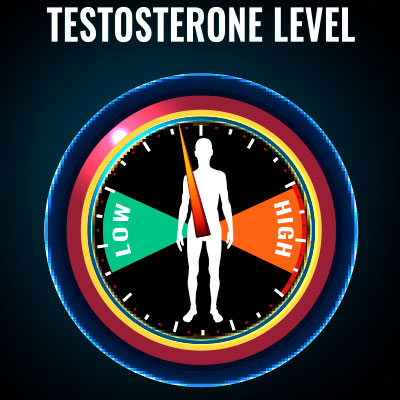Testosterone Deficiency Causes
There can be several causes of testosterone deficiency.
Testosterone deficiency is when your body is not producing enough testosterone. Testosterone deficiency, also known as "hypogonadism,” can happen at any stage of life, particularly when it develops from injury, infection, or some other disease condition.
However, testosterone deficiency is more prevalent among men and women over 40. This is because the most common cause of testosterone deficiency is the steady decline in testosterone that occurs as men and women age. Doctors refer to this condition as an “age-related testosterone deficiency.”
What Is Testosterone Deficiency?
In both men and women, testosterone is a critical hormone for your overall health and vitality. Testosterone influences your ability to build muscle. It also strengthens your bones, regulates your ability to burn fat, and is critical to sexual desire and sexual function in both men and women.
Testosterone Deficiency Syndrome, also known as “Hypogonadism,” is a condition in which your body does not produce sufficient testosterone. The condition may simply be referred to as having a “testosterone deficiency” or “low testosterone.”
There can be several causes of testosterone deficiencies, such as injury to or disease of the testes or pituitary glands, certain cancers, or genetic conditions. Some medications can also lead to a testosterone deficiency, as can stress, obesity, or alcohol abuse.
However, the most common cause of testosterone deficiency is simply the natural drop in testosterone levels as you age.
A testosterone deficiency is when your body does not produce enough testosterone.
What Causes Testosterone Deficiency?
A testosterone deficiency can be caused by an inherited (congenital) trait or something that happens later in life (acquired), such as an injury or an infection.
Several factors can contribute to an acquired testosterone deficiency. Not getting enough exercise, doing the wrong kinds of exercise, a poor diet, and metabolic conditions such as diabetes can lead to low testosterone. However, the most likely cause of testosterone deficiency is the normal drop in testosterone levels that occur as you age.
While there can be many reasons for testosterone deficiency, the condition primarily affects older men. This is because once a man is over 30, the level of testosterone in his blood starts to drop significantly. This type of age-related testosterone deficiency in men is similar to menopause in women.
It is, therefore, sometimes referred to as "andropause." However, unlike menopause, which happens at a specific time in a woman’s life, andropause in men develops more slowly over time. Once a man is over 40, his testosterone level will drop by as much as 2% per year. By age 70, the average man’s testosterone production is about half of what it was in his 20s.
Testosterone levels are measured in nanograms per deciliter (ng/dL). Typically, the normal range is 300 to 1,000 ng/dL. Anything below 300 ng/dL is considered low testosterone.
Doctors who treat low testosterone recognize two types of testosterone deficiencies: primary and secondary testosterone deficiency. Often primary and secondary testosterone deficiency occur together.
Primary Testosterone Deficiency
When you have a primary testosterone deficiency, that means that you don’t have enough testosterone due to a problem in the organs that make testosterone. In men, that is the testes, and in women, that is the ovaries or the adrenal glands. In a primary testosterone deficiency, the source of testosterone production in your body is still receiving the message from the brain to produce testosterone, but the organs are unable to produce the hormone.
Secondary Testosterone Deficiency
In a secondary testosterone deficiency, there is a problem in the areas of the brain that signal the sex organs to make or release testosterone. This type of testosterone deficiency means that you have a problem in the hypothalamus or the pituitary gland — the parts of the brain that tell the testicles to produce testosterone. The hypothalamus produces gonadotropin-releasing hormone, which signals the pituitary gland to make follicle-stimulating hormone (FSH) and luteinizing hormone (LH). Luteinizing hormone then signals the testes to produce testosterone.
There can be various causes of testosterone deficiency. However, the most common cause is age-related testosterone decline.
How Common Is Testosterone Deficiency?
Men are more likely to develop testosterone deficiency as they get older. According to the Journal of the American Medical Association, testosterone deficiency is common, affecting approximately 7% of men in their 50s, and increases with age.
It is also more common in men who are overweight and men who are in poor general health with long-term health conditions.
One large study in Europe found that testosterone deficiency affected about 2 in 100 men aged 40 to 79 years. Testosterone deficiency affected about 5 in 100 men aged 70 to 79 years.
Low testosterone or age-related testosterone deficiency occurs in women, but it is far less common than in men and is usually attributed to the overall loss of hormones that occur as women reach menopausal age. Low testosterone in women is most often associated with sexual function issues.
It is common for women with testosterone deficiency to experience hypoactive sexual desire disorder—or HSDD. HSDD is considered the most widespread sexual health problem among women, and estimates suggest it occurs in 8% to 19% of women. HSDD is characterized by a low libido or a lack of interest in sex.
How Do I Find Out If I Have Low Testosterone?
There are several signs and symptoms that can be associated with a testosterone deficiency in men and women. If you have low testosterone, you may experience:
- Reduced libido
- Difficulty obtaining or maintaining an erection (men)
- Vaginal dryness, or painful intercourse (women)
- Low sperm counts/fertility issues (men)
- Worsening of menopausal symptoms (women)
- Loss of focus and concentration
- Mood swings and anxiety
- Inability to build muscle, even while exercising
- Increase in body fat
- Memory loss and other cognitive difficulties
- Loss of lean body (muscle) mass
- Loss of bone density
Besides the signs and symptoms above, testosterone deficiencies can cause other negative effects on your health and wellbeing, such as:
- Increased risk of cardiovascular disease
- Increased risk of death from a cardiovascular event
- Increased risk of metabolic syndrome: high blood pressure, elevated insulin levels, excess belly fat, and abnormal cholesterol levels
- Strong association with diabetes
- Strong association with atherosclerotic disease of the aorta
- Higher incidence of prostate cancer
- Association with more aggressive variants of cancer
The only way to find out if you have low testosterone is to have your testosterone levels tested. This is usually done with a simple blood test. In addition to having your testosterone level tested, your doctors will take a complete medical history and do a thorough medical exam before offering a diagnosis of low testosterone.
Any doctor can perform the typical blood test for low testosterone. However, if you suspect that you have a testosterone deficiency, it is best to be tested by a doctor who specializes in age-related hormone imbalances in men and women.
The Latest Medical Research About Testosterone Deficiency
There is a lot of ongoing clinical research into the causes of testosterone deficiencies and how to best treat them.
In 2015 a multi-disciplinary guideline on the management of testosterone deficiency in men was published in the Journal of the Canadian Medical Association. The guideline is “intended to address clinical questions surrounding the diagnosis of testosterone deficiency and the appropriate use of testosterone replacement therapy in the management of these patients.” One of the main conclusions of the guideline was that testosterone replacement therapy was “highly recommended” for “men with documented testosterone deficiency syndrome and no contraindications…”
A 2019 piece in the Journal of the American Medical Association said that “Testosterone is important for muscle mass, bone strength, hair growth, and sexual function. Low testosterone can cause symptoms such as low energy, poor concentration, depression, low libido, and erectile dysfunction.”
A 2016 study found that testosterone therapy improved cognition in men with testosterone deficiency syndrome. This study published in the Journal of the Canadian Urological Society said, “The group that received testosterone replacement therapy experienced significant increases in serum testosterone levels, along with improved scores in tests for cognition and memory.”
This study also concluded that “Testosterone replacement therapy does not appear to be associated with increased risk for prostate cancer or death due to cardiovascular disease.”
Now that you know a lot more about how the cause of testosterone deficiencies and how low testosterone affects men and women, why not take a minute to contact us and learn more about how hormone replacement therapy can improve your quality of life?




